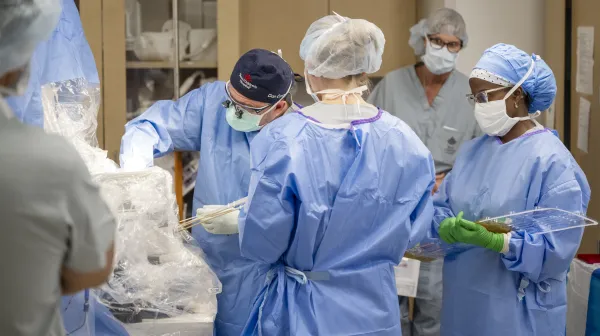Topics
Fruit flies help uncover a role for IRF2BPL in a new rare neurological disorder

Spontaneously arising mutations in a single copy of the IRF2BPL gene are associated with a previously undiagnosed neurological disorder in seven unrelated individuals, reports a recent collaborative study. Using a multidisciplinary approach that combined comprehensive clinical tests, exome sequencing and functional studies in the fruit fly model system, researchers discovered that loss-of-function mutations in this gene can disrupt normal neuronal function, and is proposed to be the likely cause of the symptoms in these individuals. The study was published in the American Journal of Human Genetics.
This project was initiated when the corresponding author of this study, Dr. Loren D.M. Pena, associate professor of pediatrics; and Dr. Vandana Shashi, professor of pediatrics, both at the Duke Clinical Site of the Undiagnosed Disease Network (UDN); connected Dr. Hugo Bellen, professor of molecular and human genetics and neuroscience at Baylor College of Medicine, an investigator at the Howard Hughes Medical Institute and the Jan and Dan Duncan Neurological Research Institute (NRI) at Texas Children’s Hospital to a patient who presented with a severe neurological condition without a diagnosis.
Eventually, one more individual was enrolled through the UDN, a National Institutes of Health-funded initiative that promotes such multi-institutional collaborations to facilitate the diagnosis of rare disorders. The other five subjects were identified through GeneMatcher, a web tool developed by the Baylor-Hopkins Center for Mendelian Genomics, to connect patients with rare disease researchers and physicians.
In this cohort, five patients had similar severe steady regression of previously acquired motor and language skills and did not fit in the diagnostic criteria for any known neurological disorder, while the other two had a milder version of the condition with autism, seizures and global developmental delays.
The UDN team of physicians and scientists collaboratively identified the gene that was altered in these patients. They compared the exomes, i.e. DNA sequences that get converted to proteins, of seven patients and their family members to the collection of exomes obtained from healthy human population. This process is akin to finding a needle in a haystack because most people have many genetic variants, many of which are benign and do not cause disease.
Interestingly, all the subjects in this study were found to carry mutations in the IRF2BPL gene, which has not been well studied in humans. Five of them had single nonsense mutation, which means a ‘stop’ signal had been erroneously introduced within the gene’s protein coding region. This type of mutation results in the production of a truncated protein that usually cannot function normally. The other two subjects had a missense mutation in IRF2BPL. This type of mutation changes a single ‘letter’ in the protein’s genetic code resulting in the substitution of one amino acid – the building blocks of proteins – for another in the protein made by the gene, resulting in a functionally altered full-length protein.
The researchers saw a remarkable correlation between the type of IRF2BPL mutation and the course and severity of clinical symptoms. The five subjects with nonsense mutations experienced severe and steady regression of motor and verbal skills, whereas the patients with missense mutations had relatively milder symptoms.
Both the nonsense and the missense mutations were de novo or new in the patients, meaning they were not genetically inherited from their parents. The mutations were also dominant; meaning only one of the two copies of the gene is defective in the patients, and this is sufficient to cause disease.
Since very little was known about the role of IRF2BPL in the brain, the Model Organism Screening Core (MOSC) of UDN based at Baylor College of Medicine and spearheaded by Drs. Bellen, Michael Wangler and Shinya Yamamoto, assistant professors at Baylor and investigators at the NRI, used the fruit flies (Drosophila melanogaster) to understand its biological function. The fly homolog of IRF2BPL is also a poorly characterized gene named pits. Dr. Paul Marcogliese, postdoctoral fellow and lead author on the study, generated mutant flies that lacked pits using the CRIMIC technology that was recently developed in the Bellen lab.
Flies lacking the pits gene failed to survive past embryonic stages, indicating this protein has an essential role during early development. Surprisingly, the researchers found that while the expression of the normal IRF2BPL gene in the proper genomic context suppressed the lethality, the presence of excess protein did not. This shows that cellular levels of IRF2BPL/Pits protein are precisely regulated – neither too little or too much is tolerated. Interestingly, six out of seven pathogenic human IRF2BPL variants abolished or diminished Pits function in flies.
Further, they found Pits protein is expressed in the neurons of the adult fly brain and is particularly enriched in the mushroom bodies, the learning and memory center of the flies and in the neurons required for motor coordination and balance.
Further functional studies were conducted by specifically silencing the expression of the pits gene in the neurons using RNA interference (RNAi) technology. The researchers first performed a ‘bang sensitivity test’ to measure the resilience of flies’ neuronal systems to mechanical stress. In this behavioral assay, fly vials were repeatedly banged and the time it takes for the flies to recover was measured. Usually, wild-type flies need very little recovery time and are able to immediately climb the walls of the tubes. Young flies with reduced pits mRNA levels had similar capacity as normal flies to perform this task. However, as they aged, they became increasingly vulnerable to mechanical stress and took much longer to recover and move. This showed that partial loss of pits is sufficient to cause an age-dependent loss of neuronal function, which is in agreement with the progressive motor regression seen in some patients in the cohort.
This was further validated when they observed an age-dependent disorganization in the photoreceptors (light-sensing neurons) of the fly retina. Electron microscopic studies of the retinae of the aged pits flies revealed other signs of neurodegeneration, such as abnormal accumulation lipid droplets, which impair neuronal function.
Based on these crucial pieces of functional information, the UDN team concluded that IRF2BPL/Pits plays critical roles in the development and maintenance of neurons in the brain and functional defects in this gene is the likely cause of many of the clinical symptoms seen in at least six of the seven patients.
The functional study presented in this article provides a solid foundation for the researchers to begin probing deeper into the normal function of this gene and possibly develop potential therapies to alleviate the symptoms in patients.
To learn more about this genetic condition visit:
- IRF2BPL Support Group - a website that integrates clinical and scientific information about IRF2BPL-related disorders.
- Stand by Eli Foundation: https://standbyeli.org/
- His Beautiful Smiles: http://leosena.blog.fc2.com/





